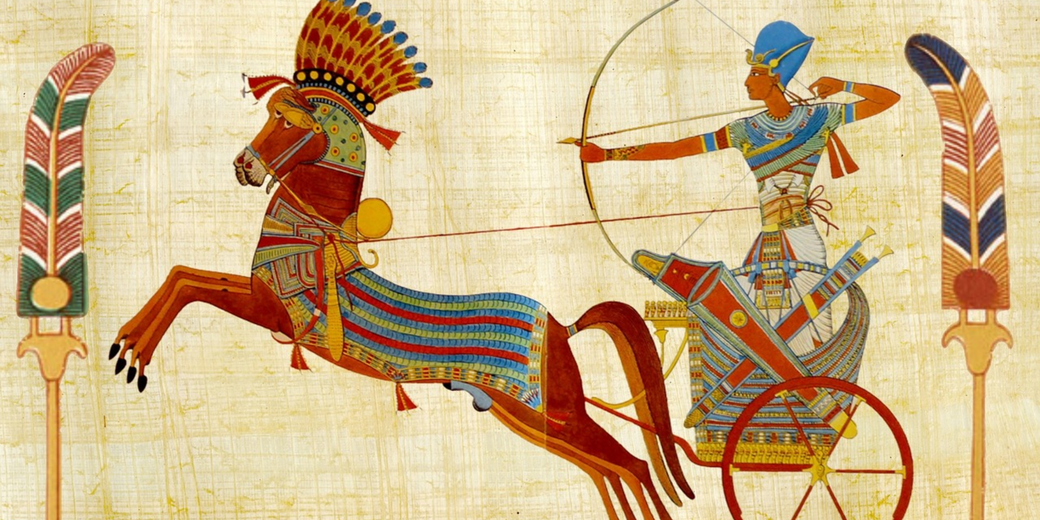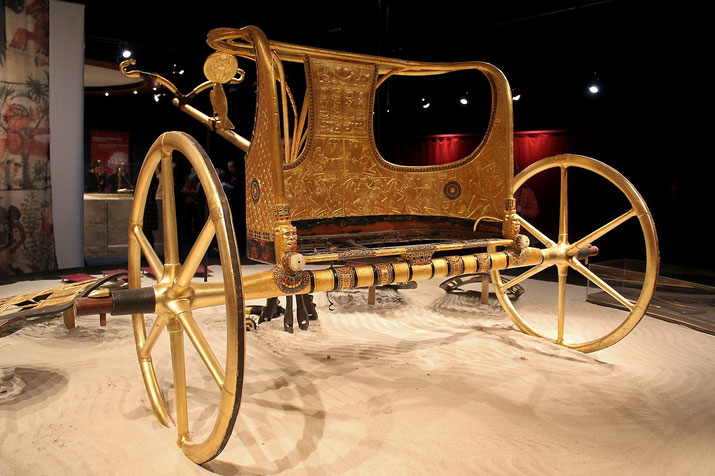How the development of the chariot changed ancient Egyptian warfare forever

Ancient Egyptian chariots, emblematic of the power and prestige of the New Kingdom period (c. 1550-1070 BCE), were an integral part of the military and cultural fabric of the time.
These fast-moving, lightweight vehicles revolutionized warfare, enabling pharaohs to project their might and influence over vast territories.
Here, we will examine the history, design, and cultural significance of these iconic vehicles.
Origins of the chariot
The development of chariots began in the Near East around 3000 BCE, with the earliest known examples originating from Sumer in Mesopotamia.
These early vehicles were heavy, four-wheeled carts, primarily used for transportation and pulled by onagers or donkeys.
Over time, the design evolved, becoming lighter and more maneuverable.
Around 2000 BCE, the two-wheeled chariot emerged in the region between the Black and Caspian Seas.
The introduction of spoked wheels made the chariots lighter, faster, and more suitable for warfare.
The domestication of horses, which were stronger and faster than onagers or donkeys, further contributed to the development of chariots as effective vehicles for war and transportation.
The Hittites and the Kassites, both powerful civilizations in the Near East, adopted chariots around 1700 BCE.
They used these vehicles in military campaigns, enabling them to expand their territories and influence.
The Hittite chariots were particularly advanced, with a lighter and more flexible design that allowed them to traverse various terrains.
How they were introduced to Egypt
The introduction of chariots to Egypt occurred during the Second Intermediate Period (c. 1650-1550 BCE), a time marked by the decline of the Middle Kingdom and the fragmentation of Egyptian power.
During this period, the Hyksos, a Semitic-speaking people from Western Asia, migrated to and settled in the Nile Delta.
They eventually established their rule over the northern part of Egypt, creating the 15th Dynasty.
The Hyksos brought with them advanced technology and innovations, including the horse-drawn chariot and the composite bow.
These technological advancements provided them with a significant military edge, enabling them to maintain control over their newly acquired territories.
As they assimilated into the local culture, they also introduced these innovations to the Egyptian population.
Initially, the Egyptians may have viewed chariots with skepticism or even disdain, as they were associated with foreign domination.
However, they quickly recognized the potential of this new technology and began to incorporate it into their own military arsenal.
The Egyptian elite adopted the chariot as a symbol of power, prestige, and divine favor.
Under the reign of Ahmose I (c. 1539-1514 BCE), the founder of the 18th Dynasty and the New Kingdom, the Egyptians successfully drove the Hyksos out of Egypt.
This victory was partly due to their effective use of chariots, which allowed them to match and surpass the Hyksos in battle.
Design and construction
In the New Kingdom, the Egyptian chariots were further refined and optimized for their specific needs.
They became lighter, faster, and more maneuverable, with a design that prioritized the use of archers in battle.
They were typically made from wood, with some parts fashioned from leather and bronze.
The primary components of a chariot included the body, the wheels, and the yoke that connected the vehicle to the horses.
The body of a chariot, also known as the cab, featured a lightweight, open frame that provided a stable platform for the driver and archer.
The frame was often constructed from wood, such as acacia or elm, chosen for its strength and flexibility.
The floor of the chariot was made from woven leather straps, which offered both support and flexibility, allowing the chariot to absorb shocks and vibrations during movement.
A typical Egyptian chariot had two large spoked wheels, which made it lighter and more maneuverable than earlier solid or three-spoked wheels.
The wheels were usually made from wood and were often reinforced with rawhide or leather to increase durability.
The spokes reduced the overall weight of the wheel and allowed it to flex and absorb shocks more effectively, providing a smoother ride.

The yoke and harness system connected the chariot to the horses. The yoke was a wooden crossbar placed across the necks of the horses, with a central pole extending from it to the chariot.
The harness, made from leather straps, connected the horses to the yoke and helped distribute the load evenly.
The reins, also made from leather, allowed the driver to steer and control the horses.
Chariots were usually drawn by a pair of horses, selected for their strength, speed, and endurance.
The horses were bred and trained specifically for chariot warfare, ensuring they were accustomed to the noise, movement, and stress of battle.
The choice of horses was crucial, as they directly influenced the performance and effectiveness of the chariot.
The overall design of ancient Egyptian chariots made them highly efficient and agile vehicles that revolutionized warfare in the region.
How they were used in battle
In battle, chariots were primarily employed for offensive purposes, functioning as mobile archery platforms, and were also used for pursuing fleeing enemies, ensuring a decisive victory.
In the typical configuration, an Egyptian chariot carried two warriors – a driver and an archer.
The driver was responsible for maneuvering the chariot, positioning it advantageously for the archer to launch a barrage of arrows at the enemy.
The lightweight and agile design of Egyptian chariots allowed for swift movements, enabling them to quickly engage the enemy or disengage when necessary.
The open frame of the chariot provided the archer with a wide range of motion, allowing them to effectively target enemy soldiers, cavalry, and even other chariots.
As a result, chariots were ideal for hit-and-run tactics, as they could quickly approach enemy lines, unleash a hail of arrows, and retreat before the enemy had a chance to respond.
These rapid attacks could be repeated, sowing confusion and panic among the opposing forces.
The hit-and-run tactics often forced the enemy to break their formation, making them more vulnerable to subsequent attacks by infantry and other chariot units.
Chariots could also be used effectively to attack the enemy's flanks or rear, exploiting any weaknesses in their formation.
By launching surprise attacks from the sides or the back, the chariots could disrupt the enemy's battle plan, cause disorder in their ranks, and create opportunities for other Egyptian forces to engage and overwhelm them.
There is some evidence that Egyptian charioteers employed 'feigned retreats' as a tactic to draw the enemy into a trap.
By pretending to flee, the charioteers could lure the opposing forces into pursuit, leading them away from their main formation and exposing them to ambushes by hidden infantry or other chariot units.
Finally, after breaking the enemy's lines or forcing them into a rout, the chariots were used to chase down and eliminate fleeing soldiers.
The speed and agility of the chariots enabled them to pursue retreating forces, preventing them from regrouping and ensuring a comprehensive victory for the Egyptian army.
Famous battles involving chariots
The golden age of the Egyptian chariot coincided with the New Kingdom (c. 1550-1070 BCE), a period marked by the resurgence of Egyptian power and the expansion of its empire.
During this era, the chariot became an essential element of the Egyptian military, a symbol of power and prestige, and an integral part of cultural and religious life.
The reigns of several pharaohs during the New Kingdom exemplify the significance of chariots in both military campaigns and the projection of power:
Ahmose I (c. 1539-1514 BCE)
The founder of the 18th Dynasty and the New Kingdom, Ahmose I utilized chariots to drive the Hyksos out of Egypt and reunify the country.
The successful integration of chariots into the Egyptian military enabled Ahmose I to expand his empire and establish a period of prosperity and stability.
Thutmose III (c. 1479-1425 BCE)
Known as the "Napoleon of Egypt," Thutmose III expanded the Egyptian Empire to its greatest territorial extent.
His military campaigns, which often featured the effective use of chariots, resulted in the conquest of the Levant, Canaan, and parts of modern-day Syria.
Ramesses II (c. 1279-1213 BCE)
One of the most famous pharaohs of the New Kingdom, Ramesses II, led the Egyptian army against the Hittites in the Battle of Kadesh (c. 1274 BCE).
This battle saw the largest known chariot engagement in history, with approximately 5,000 to 6,000 chariots from both sides.
Although the battle ended in a stalemate, Ramesses II's use of chariots demonstrated their importance in projecting power and asserting Egyptian dominance.
Significance of the chariot to Egyptian culture
Beyond their military use, chariots held great cultural significance in ancient Egypt. They were a symbol of power, prestige, and divine favor, often depicted in art and literature.
Chariots were frequently featured in ceremonial contexts, such as royal processions, victory celebrations, and religious rituals.
For example, in the later period of Egyptian history, the chariot was associated with the sun god Ra, who was believed to traverse the sky in a solar barque during the day and a chariot at night.
This association imbued the chariot with religious and cosmic significance, further elevating its status in Egyptian society.
As can be seen, the ancient Egyptian chariot was a revolutionary invention that transformed the dynamics of warfare and held great cultural significance.
These versatile vehicles enabled Egypt's New Kingdom pharaohs to project their power across vast territories and solidify their status as rulers of a mighty empire.
Today, the chariot remains an enduring symbol of ancient Egypt's military prowess and cultural sophistication.
What do you need help with?
Download ready-to-use digital learning resources
Copyright © History Skills 2014-2025.
Contact via email
With the exception of links to external sites, some historical sources and extracts from specific publications, all content on this website is copyrighted by History Skills. This content may not be copied, republished or redistributed without written permission from the website creator. Please use the Contact page to obtain relevant permission.





